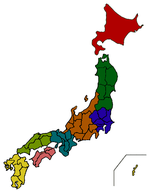Mizuki Castle
Mizuki Castle (水城, Mizuki) was built in the year 664, in the third year of the Emperor Tenji's reign[1] It was built in the Dazai urban prefecture, presently situated in central Fukuoka, Japan. It is believed it was built to be the Japanese Yamato court. The main reason for construction was that there was a fear of an invasion from the continent, and it is thought that the castle was ordered to be constructed to protect Dazaifu. There are some remains of the castle left, including some low walls in the countryside. The castle is often associated with Ōno Castle (Chikuzen Province).[2]
The name "Mizuki" means "water fortress". The castle itself was 1.2 kilometres long, 80 metres wide and 10 meters high. It had a very large moat protecting the Hazaka side of the castle.[3]
Current day site
The present site has a motorway running through it. There is nothing left of the Daifaru regional headquarters, except for an empty field. On site is a small museum, with information in English and Japanese. There is a model of Mizuki Castle in the nearby Kyushu National Museum.[4]
The Castle was listed as one of the Continued Top 100 Japanese Castles in 2017.[5]
See also
- Ōno Castle (Echizen Province)
- Ōno Castle (Chita District, Owari Province)
- List of foreign-style castles in Japan
Literature
- De Lange, William (2021). An Encyclopedia of Japanese Castles. Groningen: Toyo Press. pp. 600 pages. ISBN 978-9492722300.
References
- ^ The Japan Magazine: A Representative Monthly of Things Japanese, Volume 11 p 185
- ^ "Ono Castle" J Castle Profile http://www.jcastle.info/castle/profile/311-Ono-Castle
- ^ "Dazaifu City of Ancient Culture" http://www.furutasigaku.jp/efuruta/edazaifu/edazai2.html
- ^ Turnbull, Stephen "Japanese Castles AD 250–1540" Osprey Publishing
- ^ "続日本100名城" (in Japanese). 日本城郭協会. Retrieved 25 July 2019.
External links
- Japan Atlas
- Daizaifu, City of Ancient Culture See item 4

